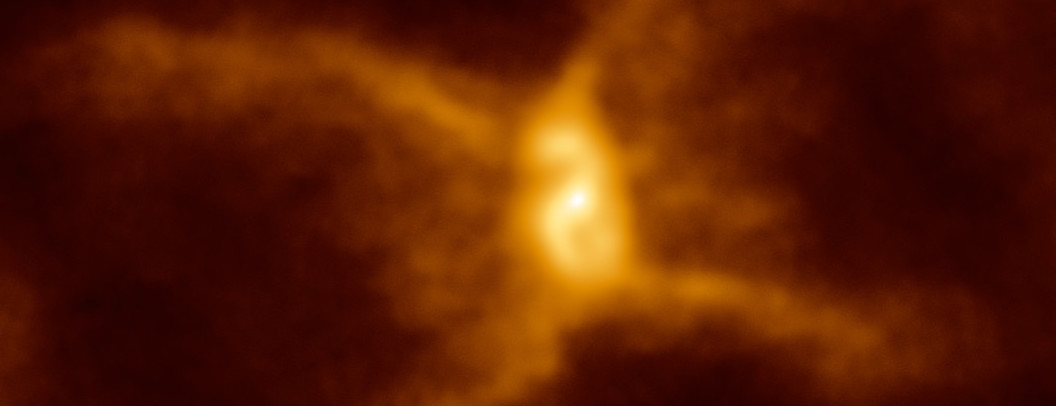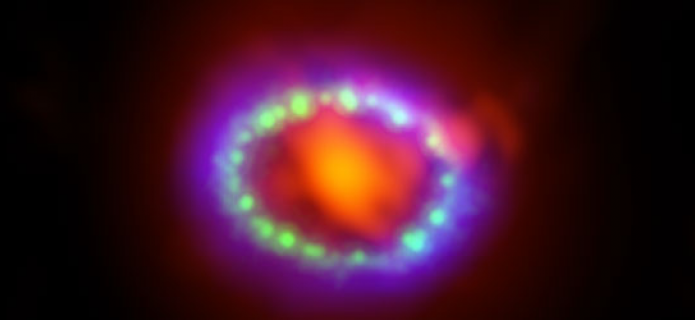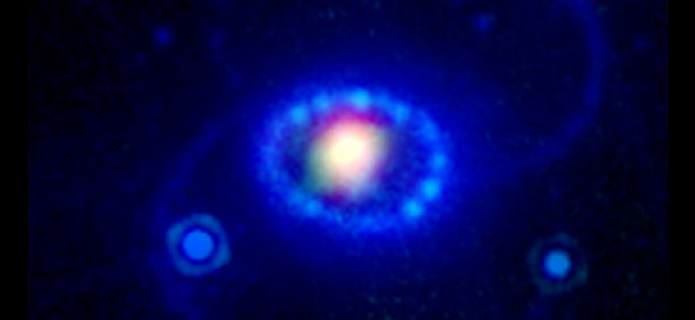When Is a Nova Not a ‘Nova’? When a White Dwarf and a Brown Dwarf Collide
Using the Atacama Large Millimeter/submillimeter Array (ALMA), an international team of astronomers found evidence that a white dwarf(the elderly remains of a star like the Sun) and a brown dwarf(a failed star without the mass to sustain nuclear fusion) collided in a short-lived blaze of glory that was witnessed on Earth in 1670 asNovasub Capite Cygni (a New Star below the Head of the Swan), which is now known as CK Vulpeculae.
In July of 1670, observers on Earth witnessed a “new star,” or nova, in the constellation Cygnus. Where previously there was dark sky, a bright pinprick of light appeared, faded, reappeared, and then disappeared entirely from view. Modern astronomers studying the remains of this cosmic event initially thought it heralded the merging of two main sequence stars – stars on the same evolutionary path as our Sun.
New observations with ALMA point to a more intriguing explanation. By studying the debris from this explosion, which takes the form of dual rings of dust and gas resembling an hourglass with a compact central object, the researchers concluded that a brown dwarf – a so-called failed star without the mass to sustain nuclear fusion — merged with a white dwarf.
“It now seems what was observed centuries ago was not what we would today describe as a classic ‘nova.’ Instead, it was the merger of two stellar objects, a white dwarf and a brown dwarf. When these two objects collided, they spilled out a cocktail of molecules and unusual isotopes, which gave us new insights into the nature of this object,” said Sumner Starrfield, an astronomer at Arizona State University and co-author on a paper appearing in the Monthly Notices of the Royal Astronomical Society.
According to the researchers, the white dwarf would have been about ten times more massive than the brown dwarf, though much smaller in size. As the brown dwarf spiraled inward, intense tidal forces exerted by the white dwarf would have ripped it apart. “This is the first time such an event has been conclusively identified,” remarked Starrfield.
Since most star systems in the Milky Way are binary, stellar collisions are not that rare, the astronomers note. The new ALMA observations reveal new details about the 1670 event. By studying the light from two, more-distant stars as it shines through the dusty remains of the merger, the researchers were able to detect the telltale signature of the element lithium, which is easily destroyed in the interior of a main sequence star, but not inside a brown dwarf.
“The presence of lithium, together with unusual isotopic ratios of the elements carbon, nitrogen, and oxygen point to material from a brown dwarf star being dumped on the surface of a white dwarf. The thermonuclear ‘burning’ and an eruption of this material resulted in the hourglass we see today,” said Stewart Eyres, Deputy Dean of the Faculty of Computing, Engineering and Science at the University of South Wales and lead author on the paper.
Intriguingly, the hourglass is also rich in organic molecules such as formaldehyde (H2CO) and formamide (NH2CHO), which is derived from formic acid. These molecules would not survive in an environment undergoing nuclear fusion and must have been produced in the debris from the explosion. This lends further support to the conclusion that a brown dwarf met its demise in a star-on-star collision with a white dwarf.
Additional Information
“ALMA Reveals the Aftermath of a White Dwarf—Brown Dwarf Merger in CK Vulpeculae,” Steward Eyres, University of Central Lancashire; Aneurin Evans, Keele University; Albert Zijlstra, Adam Avison, University of Manchester; Robert Gehrz, Charles Woodward, University of Minnesota; Marcin Hajduk, University of Warmia and Mazury; Sumner Starrfield, Arizona State University; Shazrene Mohamed, South African Astronomical Observatory; and R. Mark Wagner, The Ohio State University; Monthly Notices of the Royal Astronomical Society [Preprint: https://arxiv.org/abs/1809.05849]
The Atacama Large Millimeter/submillimeter Array (ALMA), an international astronomy facility, is a partnership of the European Southern Observatory (ESO), the U.S. National Science Foundation (NSF) and the National Institutes of Natural Sciences (NINS) of Japan in cooperation with the Republic of Chile. ALMA is funded by ESO on behalf of its Member States, by NSF in cooperation with the National Research Council of Canada (NRC) and the Ministry of Science and Technology (MOST) in Taiwan and by NINS in cooperation with the Academia Sinica (AS) in Taiwan and the Korea Astronomy and Space Science Institute (KASI).
ALMA construction and operations are led by ESO on behalf of its Member States; by the National Radio Astronomy Observatory (NRAO), managed by Associated Universities, Inc. (AUI), on behalf of North America; and by the National Astronomical Observatory of Japan (NAOJ) on behalf of East Asia. The Joint ALMA Observatory (JAO) provides the unified leadership and management of the construction, commissioning and operation of ALMA.
Images
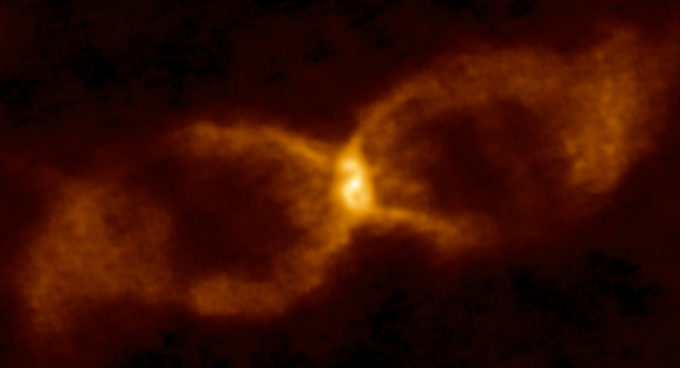
ALMA image of CK Vulpeculae. New research indicates that this hourglass-like object is the result of the collision of a brown dwarf and a white dwarf. Credit: ALMA (ESO/NAOJ/NRAO)/S. P. S. Eyres
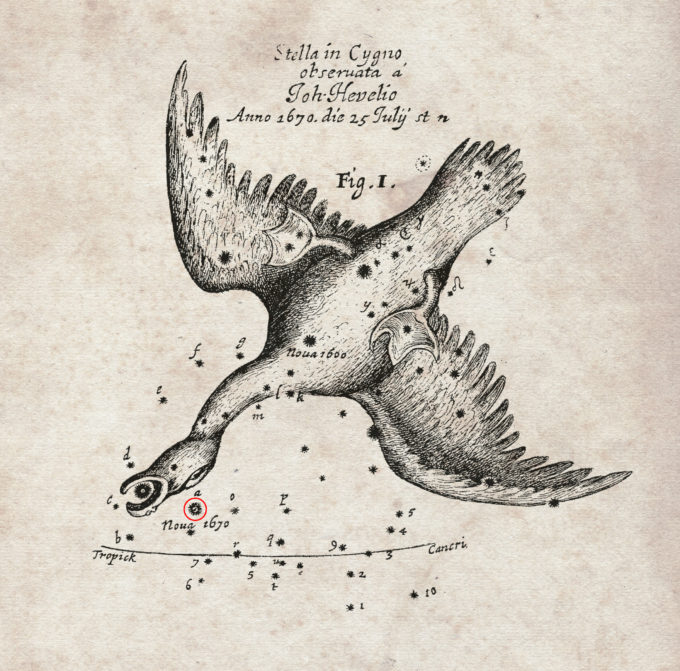
This chart of the position of a nova (marked in red) that appeared in the year 1670 was recorded by the famous astronomer Hevelius and was published by the Royal Society in England in their journal Philosophical Transactions. New observations made with ALMA and other telescopes have now revealed that the star that European astronomers saw was not a nova, but a much rarer, violent breed of stellar collision. It was spectacular enough to be easily seen with the naked eye during its first outburst, but the traces it left were so faint that very careful analysis using submillimetre telescopes was needed before the mystery could finally be unravelled more than 340 years later.
Contacts
-
Nicolás Lira
Education and Public Outreach CoordinatorJoint ALMA Observatory, Santiago - ChilePhone: +56 2 2467 6519Cel: +56 9 9445 7726Email: [email protected] -
Charles E. Blue
Public Information OfficerNational Radio Astronomy Observatory Charlottesville, Virginia - USAPhone: +1 434 296 0314Cel: +1 202 236 6324Email: [email protected] -
Calum Turner
ESO Assistant Public Information Officer -
Masaaki Hiramatsu
Education and Public Outreach Officer, NAOJ Chile
